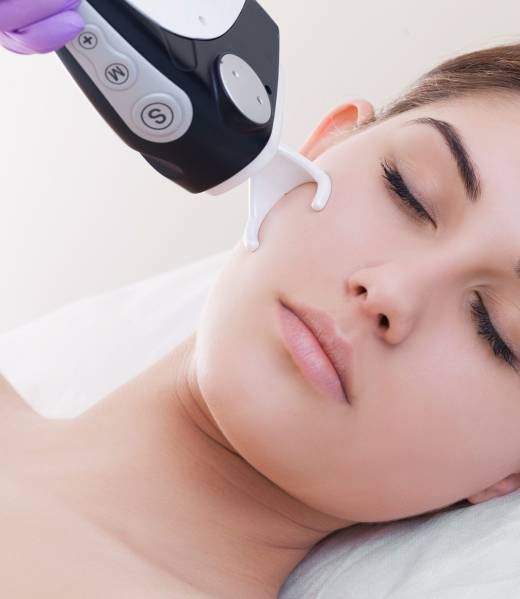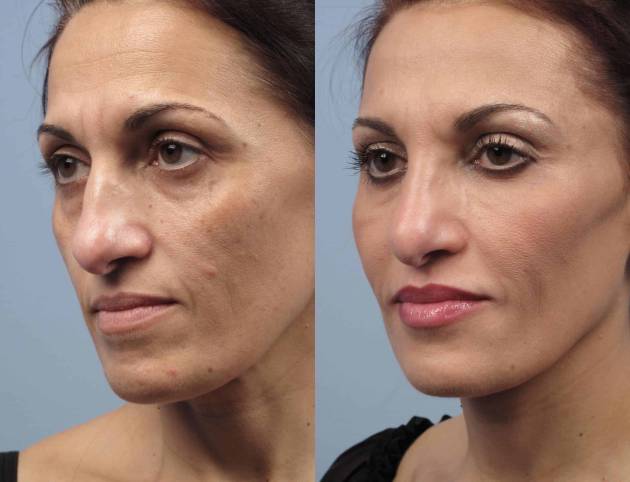
What is fractional laser treatment used to treat?
Fractional laser treatment is used for the treatment of:
- Facial lines and wrinkles (rhytides)
- Sun damage
- Skin pigmentation associated with photoageing
- Surgical and acne scarring.
Although fractional laser treatment has been advocated in the treatment of pigmentation disorders such as melasma, the treatment itself can lead to postinflammatory pigmentation.
Fractional laser treatment can be used on any part of the body but is particularly useful on the neck, chest and hands when compared to traditional ablative modalities.
Fractional laser treatment may also be of benefit for poikiloderma of Civatte and stretch marks.
Fractional laser treatment can be used in all skin types and patients, but techniques vary depending on patient age, skin type, sun exposure and body location. Fractional laser treatment can be combined with surgery and other skin treatments.
Fractional Laser Resurfacing for Aging Skin
In fractional laser skin resurfacing, a device called a fractional laser delivers precise microbeams of laser light into the lower layers of skin, creating deep, narrow columns of tissue coagulation. Coagulated tissue in the treatment area stimulates a natural healing process that results in fast growth of healthy new tissue.
The procedure can be used on the face, neck, chest, arms and hands. Discomfort during treatment typically is minimal. The approach produces long-lasting results with virtually no downtime. A series of treatments over a one- to four-week interval may be required to achieve the desired results.
Fractional laser treatment has bridged the gap between the ablative and non-ablative laser techniques used to treat sun-damaged and ageing skin. While ablative laser treatments work mainly on the epidermis (surface skin cells) and non-ablative treatments work solely on dermal collagen (mid-layer of skin) only, fractional laser treatment works at both the epidermal and dermal layers of the skin.
The first fractional laser marketed was the Fraxel® device [Reliant Technologies now Solta], which emits a non-ablative 1550-nm wavelength. There are now some machines available that use fractional technology, based on erbium:YAG lasers for superficial treatments and CO2 lasers for deeper ablative treatments (eg Fraxel Repair [Solta Medical], Active and Deep FX [Lumenis], Quadralase [Candela] and Pearl Fractional

How does fractional laser treatment work?
To understand how fractional laser treatment works a basic understanding of skin structure is required. Briefly, skin consists of 3 layers, the epidermis (uppermost layer), dermis (mid-layer) and subcutis (lower fat layer). The epidermis contains pigment-producing cells called melanocytes, which are responsible for skin colouring. The dermis is made up of collagen and elastin fibres that provide skin with strength, toughness, elasticity and pliability (click here for detailed information on skin structure).
As the body ages, the appearance and characteristics of the skin alter. The epidermis becomes thinner, so blemishes become more visible, and collagen in the dermis is gradually lost which contributes to the formation of facial lines, sagging skin and wrinkles.
Fractional laser treatment works by targeting both the epidermis and dermis. It does this by delivering a laser beam that is divided into thousands of tiny but deep columns of treatment into the skin. These are called microthermal treatment zones (MTZs). Within each MTZ old epidermal pigmented cells are expelled, and the penetration of collagen in the dermis causes a reaction that leads to collagen remodelling and new collagen formation. By using MTZs, the laser targets and treats intensively within the zone while surrounding healthy tissue remain intact and unaffected and helps heal the wound. This fractional treatment results in a faster healing process than if all tissue in the treatment area was exposed to the laser.
What does fractional laser treatment involve?
The following is an outline of the Fraxel® procedure:
Pre-treatment assessment/preparation
- Define problem areas and tailor a treatment pattern to target the areas for correction.
- Take pre-treatment photographs.
- Pre-treatment with bleaching cream (eg, hydroquinone) or chemical peel may be necessary for patients with darker skin or pigmentation problems.
- Consider aciclovir or valaciclovir prophylaxis against herpes simplex infections (cold sores)
- The patient needs to remove all jewellery and makeup. Wash face with soap and water before treatment.
- An anaesthetic cream is applied to the treatment area. It takes about 45-60 minutes for the anaesthetic to take full effect.
- The anaesthetic cream is removed, and a gliding gel is then applied to the treatment area, which helps the laser to lay down an even MTZ spot pattern.
Application of fractional laser
- The gliding gel acts as the contact lubricant for the robotic handpiece that glides across the skin surface.
- Treatment time will depend on the areas being treated, but a full face will take around 30 minutes.
- The pain associated with the procedure is dependent on the energy delivered to the treatment site. It is essential that the strong anaesthetic cream provided with the Fraxel laser is used.
- A cooling device, called a Zimmer™ machine, is used to reduce the discomfort during the procedure.
Post-treatment and recovery
- The gliding gel is washed off after the treatment.
- Patients may experience a mild sunburn sensation for about an hour after the procedure.
- Swelling is usually minimal and should resolve in 2–3 days.
- The skin will have a pinkish tone for 3–5 days.
- Within 24 hours new epidermal skin develops and the skin will have a bronze appearance that can last 3–14 days. Flaking of the skin may also occur as new skin replaces dead skin tissue, which can be treated with a moisturising cream.
- Skin peeling can be pronounced after ablative therapy when the skin should be gently removed with tap water, petrolatum and gauze once or twice daily.
- During the healing phase and for several months after treatment, it is recommended that the treatment area is protected using a moisturising sunscreen with an SPF of at least 50+. Protective clothing and wide-brimmed hats should also be used to protect the skin from sun exposure.
Four to five treatments with Fraxel® are required, depending on the energy level used and the condition of the treated skin. These are spaced one month apart. The results are not immediate and are slowly progressive, with optimal improvement visible over a three to four month period. This timeframe and treatment regimen allows for complete healing and replacement of damaged tissue with new collagen and elastin, and viable, healthy skin cell growth.
Ablative fractional resurfacing lasers are more aggressive than non-ablative devices, so recovery takes a little longer.
